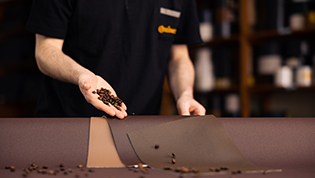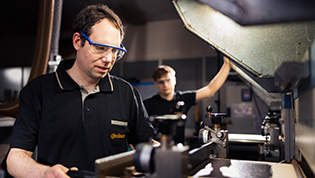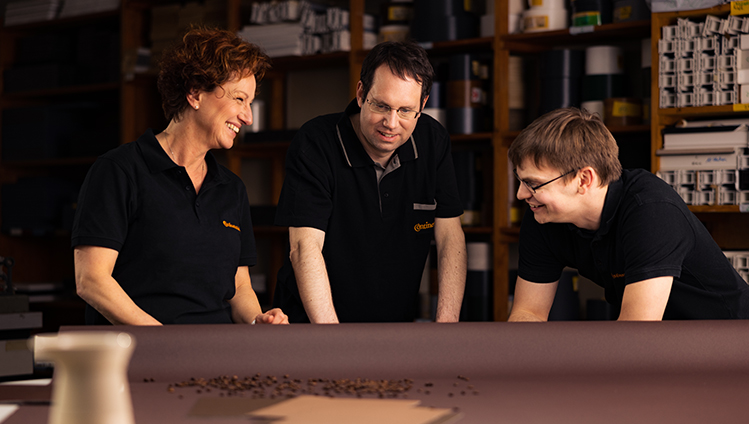 It is said that the best ideas are born out of coffee-break chats. Dr. Thorsten Neumann, Head of Research Coatings at Continental, can confirm this. “But I actually prefer to drink tea,” says Neumann. “However, small breaks in the coffee kitchen are also part of the information exchange for me.” During one of these breaks, the coffee machine briefly refused to do its job, as it often does – without any great problem, just with the flashing indicator: “Empty the grounds container.” When a colleague reacted and tipped out the container, it got Neumann thinking. He rubbed some of the coffee grounds between his fingers and thought:
It is said that the best ideas are born out of coffee-break chats. Dr. Thorsten Neumann, Head of Research Coatings at Continental, can confirm this. “But I actually prefer to drink tea,” says Neumann. “However, small breaks in the coffee kitchen are also part of the information exchange for me.” During one of these breaks, the coffee machine briefly refused to do its job, as it often does – without any great problem, just with the flashing indicator: “Empty the grounds container.” When a colleague reacted and tipped out the container, it got Neumann thinking. He rubbed some of the coffee grounds between his fingers and thought:
Coffee grounds are bio-based and produced as a virtual by-product in vast quantities – and at the same time they have exciting material properties and can be classified as sustainable. Possibly a candidate as a raw material for a sustainable artificial leather?
Reading coffee grounds with the colleague
“We are always looking for ways to make our products even more sustainable – for example, by increasing the proportion of natural and renewable raw materials,” explains Neumann. “For our upholstery fabrics with so-called laif technology, we focus on functionality and sustainability. This makes the upholstery fabrics and artificial leathers sustainable and at the same time breathable and air-permeable – in other words, perfect for seating with integrated passive climate control.” Neumann was immediately able to inspire his colleague Andreas Heckel, Development Specialist in Research Coatings, with the coffee grounds idea. Heckel thought about it for a moment – and finally said, “Yes, let’s try out the idea in the lab right away.” Today – a few years after the coffee break brainstorm – Continental offers its customers the innovative skai VyP Coffee artificial leather based on coffee grounds.

As with good coffee: the grinding grade makes the difference
“The idea of using coffee grounds as a raw material fascinated me immediately,” says Heckel enthusiastically. “It is of natural origin, binds methane and carbon dioxide, and is mass produced in households and offices in this country.” In fact, every German drinks an average of 170 liters of coffee per year. This produces around 1 million tons of coffee grounds annually. Some of this is now replacing chemically produced raw materials in the skai VyP Coffee upholstery fabric. For this purpose, the coffee grounds are first dried and ground very finely. The result is a paste that is enriched with various other raw materials. “To summarize, it sounds simple, but there were a lot of factors that we had to investigate and adjust in order to achieve such a successful material: the drying must be just right, the grinding grade must not be too fine or too coarse, and in the end, of course, it all comes down to the right blend,” explains Neumann. “Working in the lab we were always aware of a mild coffee smell.”
A location with coffee in its blood
 The company was able to increase the proportion of natural, renewable and recycled constituents in skai VyP Coffee to 65 percent. “This includes not only coffee grounds, but also recycled PET and cotton fibers, rock salt and bio-based plasticizers,” explains Neumann. “We dried the coffee grounds in a climate-neutral way. For production in our plants, we already rely on green energy.” And on top of that, another remarkable energy: the commitment of the employees. “Of course, in the beginning, we needed large quantities of test material for experimental purposes. One square meter of skai VyP Coffee contains the grounds equivalent to three cups of coffee. At the Weißbach location, where the idea originated, there wasn’t a single department that didn’t support us in this. For our colleagues, the whole thing has become a favorite project,” says Neumann proudly, adding with a wink: “Those were probably the most productive coffee breaks in all of Germany.”
The company was able to increase the proportion of natural, renewable and recycled constituents in skai VyP Coffee to 65 percent. “This includes not only coffee grounds, but also recycled PET and cotton fibers, rock salt and bio-based plasticizers,” explains Neumann. “We dried the coffee grounds in a climate-neutral way. For production in our plants, we already rely on green energy.” And on top of that, another remarkable energy: the commitment of the employees. “Of course, in the beginning, we needed large quantities of test material for experimental purposes. One square meter of skai VyP Coffee contains the grounds equivalent to three cups of coffee. At the Weißbach location, where the idea originated, there wasn’t a single department that didn’t support us in this. For our colleagues, the whole thing has become a favorite project,” says Neumann proudly, adding with a wink: “Those were probably the most productive coffee breaks in all of Germany.”
In the future: more than just coffee
Coffee consumption in Weißbach is slowly getting back to normal. “In the future, cafés will be able to bring in their own coffee grounds, from which we will then produce individual cover fabrics,” Heckel explains. “This also closes the coffee cycle for the coffee shops.” In addition to the popular hot beverage, Continental is now researching other natural substances that, in the best case scenario, will not only make a potential final product more sustainable, but will even involve valuable functions. So in everyday working life, as well as during coffee breaks, the following remains true: Continental is pushing ahead with the search for new sustainable raw materials.

By the way, while researching and writing this post, the author produced so much coffee grounds that two square meters of skai VyP Coffee could easily be made with them.